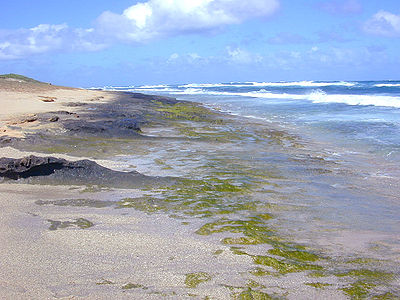Green algae are often classified with their embryophyte descendants in the green plant clade Viridiplantae (or Chlorobionta). Viridiplantae, together with red algae and glaucophyte algae, form the supergroup Primoplantae, also known as Archaeplastida or Plantae sensu lato.

A growth of the green seaweed,
Enteromorpha on rock substratum at the ocean shore. Some green seaweeds, such as
Enteromorpha and
Ulva, are quick to utilize inorganic nutrients from land runoff, and thus can be indicators of nutrient pollution.
All green algae have mitochondria with flat cristae. When present flagella are typically anchored by a cross-shaped system of microtubules, but these are absent among the higher plants and charophytes. They usually have cell walls containing cellulose, and undergo open mitosis without centrioles. Sexual reproduction varies from fusion of identical cells (isogamy) to fertilization of a large non-motile cell by a smaller motile one (oogamy). However, these traits show some variation, most notably among the basal green algae, called
prasinophytes.



0 Comments:
Post a Comment
<< Home